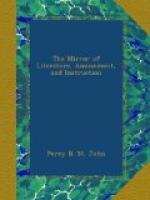MOCHA.
[Illustration: Mocha.]
“Bon pour la digestion,” said the young Princess Esterhazy, when sent to bed by her governess without her dinner; we say the same of coffee; and hope the reader will think the same of Mocha, or the place whence the finest quality is exported.
Mocha, the coffee-drinker need not be told, is a place of some importance on the borders of the Red Sea, in that part of Arabia termed “Felix,” or “Happy.” “The town looks white and cheerful, the houses lofty, and have a square, solid appearance; the roadstead is almost open, being only protected by two narrow spits of sand—on one of which is a round castle, and the other an insignificant fort.”
Lord Valentia[1] visited Mocha repeatedly during his examination of the shores of the Red Sea; and his description is the most full and minute:—
[1] From whose work the Engraving is copied.
“Its appearance from the sea is, he says, tolerably handsome, as all the buildings are white-washed, and the minarets of the three mosques rise to a considerable height. The uniform line of the flat-roofed houses is also broken by several circular domes of kobbas, or chapels. On landing at a pier, which has been constructed for the convenience of trade, the effect is improved by the battlements of the walls, and a lofty tower on which cannon are mounted, which advances before the town, and is meant to protect the sea gate. The moment, however, that the traveller passes the gates, these pleasing ideas are put to flight by the filth that abounds in every street, and more particularly in the open spaces which are left within the walls, by the gradual decay of the deserted habitations which once filled them. The principal building in the town is the residence of the dola, which is large and lofty, having one front to the sea, and another to a square. Another side of the square, which is the only regular place in the town, is filled up by the official residence of the bas kateb, or secretary of state, and an extensive serai, built by the Turkish pacha during the time that Mocha was tributary to the Grand Seignior. These buildings externally have no pretensions to architectural elegance, yet are by no means ugly objects, from their turretted tops, and fantastic ornaments in white stucco. The windows are in general small, stuck into the wall in an irregular manner, closed with lattices, and sometimes opening into a wooden, carved-work balcony. In the upper apartments, there is generally a range of circular windows above the others, filled with thin strata of a transparent stone, which is found in veins in a mountain near Sanaa. None of these can be opened, and only a few of the lower ones, in consequence of which, a thorough air is rare in their houses; yet the people of rank do not seem oppressed by the heat, which is frequently almost insupportable to a European.




